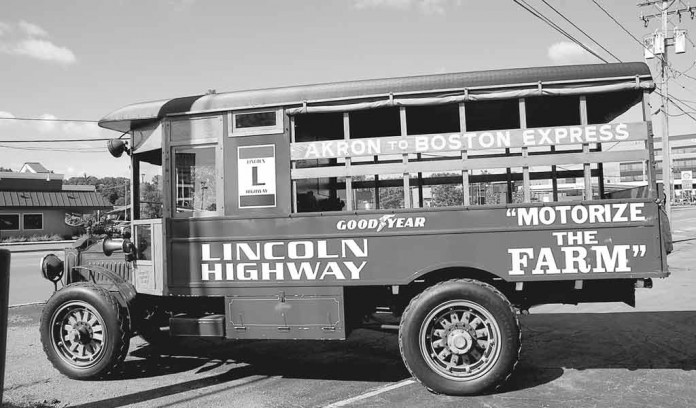For the first few years of the “horseless carriage,” motor vehicles were lightweight and intended to carry a few passengers only. Human nature being what it is, men soon began exploring ways to carry heavier loads and a few light gasoline and electric powered delivery wagons were available by 1900.
Many of these early motor vehicles rolled on the same wooden wheels and solid rubber tires as the carriages they soon replaced, while others were equipped with the high-pressure air tires used on bicycles.
Heavier and heavier trucks were soon developed, but they were slow, 15 mph was fast for the big trucks of the time, partly because of the rough ride on the solid truck tires then in use.
Local deliveries
Trucks were used primarily in towns as delivery vehicles for stores, by breweries, who were the largest users of trucks according to a 1913 survey, and to move goods to and from railroad express stations.
The long distance movement of freight was left almost exclusively to the railroads. By 1917, trucks smaller than 1 ton were mostly riding on pneumatic tires but truckers were sure air tires couldn’t support heavy loads.
Goodyear’s plant manager, Paul Litchfield, was positive such tires could not only carry heavy loads, but do it with better traction and flotation and at higher speeds than the solid tires, so he decided to prove it.
Getting bigger
A 1917 Packard 5-ton truck engine and chassis was purchased, which Goodyear equipped with large pneumatic tires with a diamond tread and a specially built cab and body. The wide wooden cab had a sleeping compartment behind the driver’s seat, and behind that an open rack-type body, that was loaded with 12 spare tires and an air compressor, as well as tools, shovels, block and tackle and 500 feet of rope.
In April of 1917, two drivers, Harry Apple and Harry Smeltzer, left Akron for the nearly 800-mile trip to the Goodyear fabric mill in Killingly, Connecticut. The truck was accompanied by two cars carrying a tire engineer, an advance man and publicist, and a cameraman to record the trip. The two Harrys alternated driving duties, with one sleeping while the other drove and both worked like beavers when the truck got stuck or broke through a wooden bridge, which happened frequently.
Out of holes
The dirt roads of the day were turned into mud holes by spring rains and before the truck had traveled far, a winch and more rope were acquired. Bridges were shored up or rebuilt and the drivers became proficient at getting the truck out of holes.
Then there were the blowouts — one about every 75 miles. Due to wear and tear from the bad roads, the two cars had to be replaced by the time they reached Pittsburgh, a matter of not much more than 100 miles.
The Packard wasn’t immune to this abuse — twice the engine had to be rebuilt. The advance man ranged ahead of the truck and saw that a news release was put in the paper of every town along the route. Each place the truck stopped a crowd of locals gathered around the big Packard. Smeltzer later remembered, “People would come around, kick the tires and want to know if they were solid or pumped up.”
The convoy continued east through Pennsylvania and New Jersey to New York City and Connecticut. Most accounts say this first trip went to Boston first and returned through Killingly, Connecticut, where it was welcomed by a brass band and girls from the Goodyear fabric mill, although no cargo for Boston is listed. Anyway, a load of cotton fabric for reinforcing tires was loaded in Killingly, and the crew started for home.
Long trip
As driver Harry Smeltzer put it, the trip out “took 28 days and 28 tires,” but the return trip was completed in just five days due to better weather. After examining the 28 tires that had failed, Goodyear engineers increased sidewall strength and made the beads heavier.
With these improved tires, Goodyear’s Wingfoot Express established regularly scheduled service between Akron and Boston. Seven 3-5-ton Packard, White and Mack trucks hauled tires and rubber shoe soles and heels to the Boston area and returned through Killingly, where they loaded up with cotton fabric for the Akron tire factory.
In 1918, due mostly to the war, the Wingfoot Express expanded its efforts. A Goodyear truck took a load of tires to Chicago and loaded 18 tons of Red Cross supplies that were urgently needed in France. Some 100 hours later, the supplies were unloaded on the dock at Baltimore and loaded on a ship. That same year several trips were made to San Francisco carrying airplane tires for the U.S. Army.
Bridges collapsed
The record states that while crossing Wyoming, 36 out of 56 total bridges collapsed and had to be repaired. On the 4th trip to the west coast, the Goodyear trucks did it in a record 14 days.
Today, millions of trucks move billions of tons of cargo over trillions of miles every year, all at a high speed and in a safe manner — and it all began with two truck drivers named Harry.













